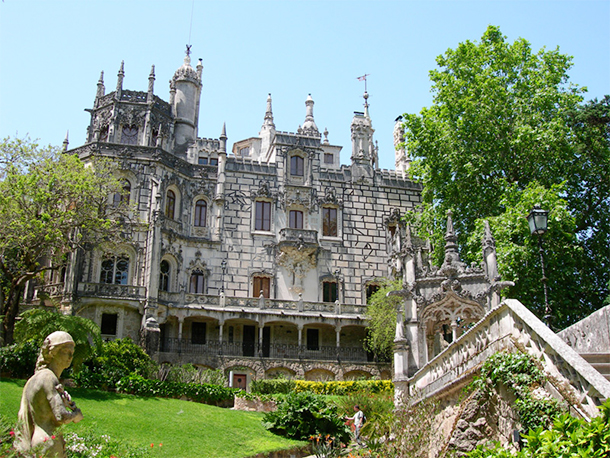An Unsolved Mystery
One of the most intriguing aspects of the Initiation Well is its apparent lack of a natural light source. Even though the well's depths remain cloaked in mystery, a subtle glow seems to emanate from within, leaving onlookers questioning where this light comes from. Despite countless theories and investigations, the source of the light remains unexplained, making the well all the more enigmatic.The History of Quinta da Regaleira's Initiation Well
The estate’s iconic well was designed by Italian architect Luigi Manini, under the guidance of Carvalho Monteiro, a Brazilian-Portuguese aristocrat. Monteiro, a reputed Freemason, purchased the estate in 1892 and commissioned a fantastical landscape where symbols representing his interests could intertwine. The well reflects an eclectic mix of architectural styles, including Roman, Gothic, Renaissance, and Manueline influences. The estate's history and Monteiro's vision are intricately woven into the fabric of the well's design.
 The Wishing Well
The Wishing Well
Many visitors regard the Initiation Well as a wishing well, dropping coins into its depths while making silent prayers and wishes. However, the well continues to draw curiosity for a deeper mystery: the origin of the eerie light that flickers from within. Tourists are left pondering this unsolved riddle, adding to the well's allure.What Was the Initiation Well Used For?
Though shrouded in mystery, it is widely believed that the Initiation Well was used for secret, ritualistic ceremonies. Many theories suggest the well's primary purpose was for initiation rites associated with the Knights Templar. Initiates would descend the spiral staircase into complete darkness and emerge symbolically from the underworld into light and enlightenment. Some also speculate that the well was connected to Tarot mysticism, with the number of landings and steps symbolizing the stages of spiritual ascent. Others believe the well was used for rituals tied to Freemasonry or Rosicrucianism, making it a focal point for occult practices.
 The Underground Tunnels
The Underground Tunnels
At the bottom of the well lie four tunnels, which extend toward grottos and a secondary well. The walls, tinged with pink and brown hues, are said to represent the journey from death to rebirth, darkness to enlightenment. These tunnels, like much of the estate, symbolize the passage from ignorance to knowledge and are believed to have been used during clandestine initiation ceremonies. Unlike traditional wells, this one was not meant for gathering water but for deeply symbolic and ritualistic purposes.A Place Full of Mysteries
The Initiation Well is as deep as a four-story building and narrows as it descends. Known as the Labyrinthic Grotto, the well appears like an inverted tower that leads underground. A smaller well located nearby is connected through the system of tunnels, linking the mysterious network of passages. Situated on the grounds of Quinta da Regaleira, which is recognized as a UNESCO World Heritage Site, the well continues to captivate the imagination of those who visit.

One of the most intriguing aspects of the Initiation Well is its apparent lack of a natural light source. Even though the well's depths remain cloaked in mystery, a subtle glow seems to emanate from within, leaving onlookers questioning where this light comes from. Despite countless theories and investigations, the source of the light remains unexplained, making the well all the more enigmatic.The History of Quinta da Regaleira's Initiation Well
The estate’s iconic well was designed by Italian architect Luigi Manini, under the guidance of Carvalho Monteiro, a Brazilian-Portuguese aristocrat. Monteiro, a reputed Freemason, purchased the estate in 1892 and commissioned a fantastical landscape where symbols representing his interests could intertwine. The well reflects an eclectic mix of architectural styles, including Roman, Gothic, Renaissance, and Manueline influences. The estate's history and Monteiro's vision are intricately woven into the fabric of the well's design.
 The Wishing Well
The Wishing WellMany visitors regard the Initiation Well as a wishing well, dropping coins into its depths while making silent prayers and wishes. However, the well continues to draw curiosity for a deeper mystery: the origin of the eerie light that flickers from within. Tourists are left pondering this unsolved riddle, adding to the well's allure.What Was the Initiation Well Used For?
Though shrouded in mystery, it is widely believed that the Initiation Well was used for secret, ritualistic ceremonies. Many theories suggest the well's primary purpose was for initiation rites associated with the Knights Templar. Initiates would descend the spiral staircase into complete darkness and emerge symbolically from the underworld into light and enlightenment. Some also speculate that the well was connected to Tarot mysticism, with the number of landings and steps symbolizing the stages of spiritual ascent. Others believe the well was used for rituals tied to Freemasonry or Rosicrucianism, making it a focal point for occult practices.
 The Underground Tunnels
The Underground TunnelsAt the bottom of the well lie four tunnels, which extend toward grottos and a secondary well. The walls, tinged with pink and brown hues, are said to represent the journey from death to rebirth, darkness to enlightenment. These tunnels, like much of the estate, symbolize the passage from ignorance to knowledge and are believed to have been used during clandestine initiation ceremonies. Unlike traditional wells, this one was not meant for gathering water but for deeply symbolic and ritualistic purposes.A Place Full of Mysteries
The Initiation Well is as deep as a four-story building and narrows as it descends. Known as the Labyrinthic Grotto, the well appears like an inverted tower that leads underground. A smaller well located nearby is connected through the system of tunnels, linking the mysterious network of passages. Situated on the grounds of Quinta da Regaleira, which is recognized as a UNESCO World Heritage Site, the well continues to captivate the imagination of those who visit.










